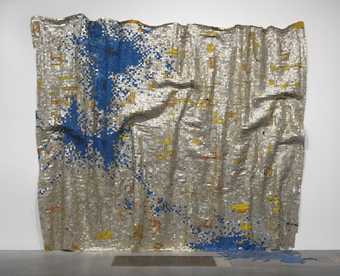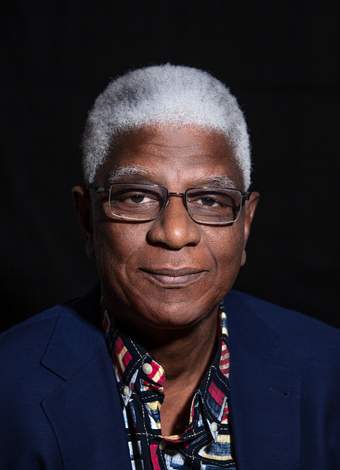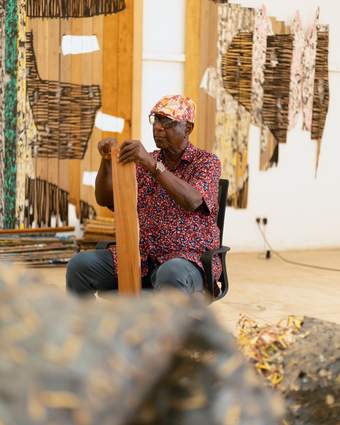
El Anatsui and details from his studio in Accra, Ghana, photographed by Ask Photos, June 2023
OSEI BONSU Can we start by talking about your early life? Your mother passed away when you were young, and you were raised by your uncle. What are your memories of that time?
EL ANATSUI My uncle was a Presbyterian pastor in Anyako, a town in southeast Ghana, so we lived with him in the mission house. Life in a mission house was quite different from life in the town itself. Our world was limited to the church and school. We didn’t have much exposure to the things that my classmates were exposed to – Ghanaian culture, other cultures. And my language skills were poor. I couldn’t use the right language and was scared to try. I was very isolated in that respect.
OB As a result, did you develop a curiosity for the wider culture that you didn’t have access to?
EA Yes, and I think it became evident in school. My solution was to search for new languages. I noticed local Ghanaian craftsmen or artists working with the Adinkra symbols, this body of signs that are often printed on fabrics or used in pottery. I saw them collected on a sheet of paper one day and suddenly had a one-stop experience of symbols and meanings.
OB Your closest relationship, it seems, was with your uncle, but you’re one of 32 children. I’m curious to know what role your wider family played?
EA My mum was an artist. She was able to design, construct and sew dresses without any training. Several of my siblings were artistic, and other members of the family were drummers.

El Anatsui and details from his studio in Accra, Ghana, photographed by Ask Photos, June 2023
OB Your own artistic skill began to develop when you were in secondary school…
EA I got prizes in art, but also in other subjects. It was a strange thing for somebody like me to consider art as a profession, so I didn’t give it much thought. When I was in my final year, however, a team from a university came to speak to us. I was fascinated by one chap who spoke about art, because I had been interested in it in one form or another throughout my childhood. I decided to apply.
OB You were at high school when Kwame Nkrumah became president, and you came of age during the decade of independence launched in 1957. Your youth, in a way, bisected an important transition in Ghana’s political, social and cultural history. What was your memory of that period? Was there any recognition of Pan-Africanism in your ideology at that time?
EA We weren’t old enough to be dealing with ideology, but by the time I got to university there was this phenomenon of trying to rediscover ourselves as Ghanaians after independence. We wanted to know what our identity was.
OB When you got to art school in Kumasi in Ghana, was the curriculum limited in terms of access to African artists and art historians? You once said: ‘When I left art school, my idea was to try to indigenise, to get a bit of indigenous material into my psyche’.
EA Most of the time, I would finish whatever project I had been set, then put it aside and set myself my own project. I would go to the library to read about art history and such things. I wasn’t consciously throwing away what the school taught me, but one has to question where one has to go, where one practices as an artist. In school, we used imported materials, such as plaster of Paris. Indigenous materials – clay, wood – we used sparingly. Eventually the school engaged a local artist to come and take us through traditional wood carving, a very skilful technique using an adze and no mallet, creating these beautifully straight lines. But that was about it. One of the first questions I had to ask myself was: ‘What materials do you want to use?’
After I graduated, I started working with the Adinkra symbols, just copying them and getting to know their meanings. Then, one day at the market I spotted some trays, which the market women were using to display their wares, and the idea came to me that this could be a material I could work with. I made enquiries with the women, and discovered where their trays were from and who produced them. I found the workshop, and I would go there and design different trays using the Adinkra. The Adinkra are normally presented in a group, but I decided to isolate each one and put them on the trays. If you isolate something you give it more prominence, more attention. That was a kind of beginning.
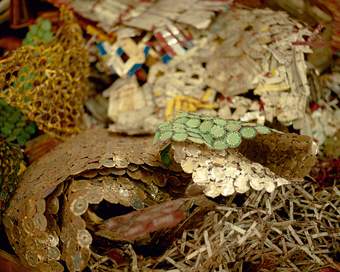
El Anatsui and details from his studio in Accra, Ghana, photographed by Ask Photos, June 2023
OB Was it at around this time that you started to realise the possibilities of working with other craftspeople and artists?
EA I think that was the first time. Also, I had started working as an art teacher around that time and I began to enlist my students to work at the weekends. They helped me to work on the trays, using a low-tech way of heating rods in a fire and leaving them to make their marks.
OB Where do you think that model of co-production came from? Because it bears a parallel not only with the Renaissance but also with the Ghanaian and African tradition of the craftsperson and apprentice.
EA If you cast your mind back you can think, okay, this is the model that has existed – it’s not a new thing. But for me it happened organically. When I left art school, I was kind of a purist. I believed that the artwork had to be something that you did, that you made with your own hands. But as I started working with other people I thought that, as an artist, my job is to generate ideas, not necessarily realise them.
I’ve always believed that art is not a practice in which you keep to tradition. Tradition is there to give you a springboard. Tradition is there to show us what there is to change, or what not to change.
OB Speaking of traditional crafts, I wanted to ask about Broken Pots 1977–81, which is a series of ceramic sculptures you made from partially reassembled potsherds. Did you want that series to reference what was happening more widely in Ghana at the time?
EA I don’t consciously set out to focus on the political or social situation. I want the work to lead into such things organically. The broken pot idea came about when I was working with clay as a material. I thought about clay as a model of life. As a child, you are malleable and soft; as a teenager you are hardened by life’s experiences; as an adult, you become rigid and eventually fragile. And when you grow old and die, there is a chance that you reincarnate, and that when you reincarnate you hold your experiences from your previous life.
I also referenced the usage of pots where I grew up – sometimes I would go to town and see offerings and sacrifices to ancestors held in broken vessels. Breaking is an opportunity for rebirth, because if something is whole, there is no change that can be made, so it continues on in its life. Breaking is not destruction but a necessity for reforming.
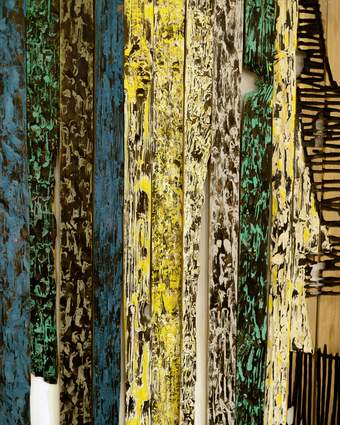
El Anatsui and details from his studio in Accra, Ghana, photographed by Ask Photos, June 2023
OB What is the connection between that early approach to materials and your later work – for instance, your hangings made from bottle caps?
EA With the bottle caps, you have to break them up in order to recompose them, and try to make them stronger and more expansive – something that they couldn’t achieve on their own. This is similar to the broken pot idea, using potsherds to create something shared. If you bring things or people together, they become more powerful than they are individually.
OB I wanted to ask about your wider integration of other forms of African mark making and language throughout your practice, and why you wanted to use these in your art.
EA I read somewhere that Africa doesn’t have a writing tradition, so when I first saw the Adinkra signs, and later, when somebody gave me a book which talked about all these other meanings of the symbols, I thought, let me use, or play with, these writing systems that people claim Africa doesn’t have. Making use of the Adinkra is a way of drawing people’s attention to the fact that these were a written form of communication.
OB With every project you approach, there seems to be a desire to explore the material itself, but also to address a set of intellectual questions – almost to resolve something that cannot be fixed. Is that true?
EA As an artist, I want to look at things in a different way. Let me use an example. I learned one way of shaping wood. But I thought: ‘Why not try other ways of shaping wood?’ And in the process of doing that I found that I have thrown more light on the material. I was showing wood in a way that people were not used to. In a way, I would extend their knowledge of wood.
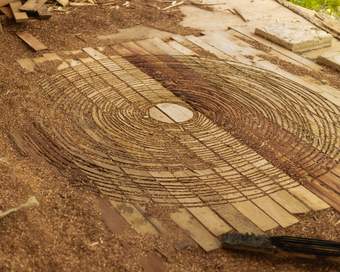
El Anatsui and details from his studio in Accra, Ghana, photographed by Ask Photos, June 2023
OB So many of your foundational works were produced during residencies or workshops, or through an encounter with a different landscape outside of Nsukka in Nigeria, to which you have a strong connection. Could you talk about your interest in ‘nomadism’ as away of working?
EA I think the nomadic aspect has to do with a concern for the environment. I source my material from the environment, but I don’t want to leave a large ecological footprint. That something is reusable, and can be moved easily, is important to me. That way, you are helping the environment.
Something that struck me when I started exhibiting internationally was that shipping artworks around the world leaves so much of a footprint on the environment. Early on in my career, I decided that I should consider things like easy transportability in terms of weight or packability. You should be able to pack things just like a nomad; you should be able to fold your tent and move. The bottle cap pieces can be folded and take up a small volume but cover huge areas.
OB When did you start to become interested in sculptures as environments?
EA I think the moment I started working with ‘throw-away’ material, I became conscious of the need for scale. You want your works to have a presence, so you build them up. Especially with the bottle caps, they have to come together and expand. The way we join the caps, for instance, leaves so much scope for them to remain strong and together. The more it grows, the more presence it has, and the more expressive it becomes.
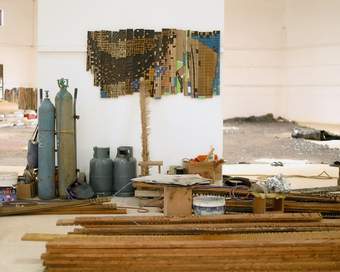
El Anatsui and details from his studio in Accra, Ghana, photographed by Ask Photos, June 2023
OB Do you think the bottle tops do something that those other materials couldn’t achieve?
EA Each material has its own physical and even spiritual properties. And each one has been able to communicate the idea of the movable or changeable form; it has to be able to be transformed. There is an organic growth that links my work from its beginnings to now.
OB What was the starting point for your thinking about this commission for the Turbine Hall?
EA I started thinking about the bottle caps, instead of the architectural space. And then I thought about the history of the institution and the name ‘Tate’. Anybody my age would know Tate & Lyle, the sugar that we ate during the colonial era. And that’s the same Tate that became responsible for this museum, which is now built for the education of society. I thought that I should play with elements from that history, from the history of the enslaved people to the commodities they produced, and the economy they helped to create.
OB You’ve said: ‘I believe that human life is not something that is cut and dried. It is something that is constantly in a state of change. So many years ago, I was a toddler, and now I am old and grey haired. If things were not so, I would have remained a toddler. I want my artworks to replicate that experience.’ At this point in your career, are you starting to think about the life that these works will have beyond your own?
EA At this time, especially after the pandemic, you can’t help but think: ‘When I go, what will happen?’ You owe so much to society, and you are thinking more like: ‘What will I have given to society?’ Your family is small, but society is large – what do we want to do for it, so that it continues to grow? Those thoughts are foremost now.
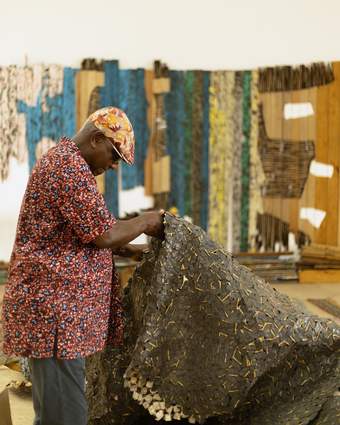
El Anatsui and details from his studio in Accra, Ghana, photographed by Ask Photos, June 2023
Hyundai Commission: El Anatsui, Tate Modern, 10 October 2023 – 14 April 2024. Curated by Osei Bonsu, Curator, International Art, and Dina Akhmadeeva, Assistant Curator, International Art, Tate Modern. In partnership with Hyundai Motor with additional support from the El Anatsui Supporter’s Circle.
El Anatsui is an artist based in Accra, Ghana.


